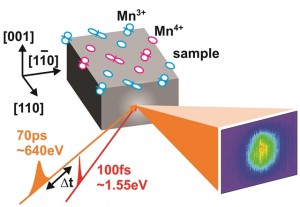A Glassy Look for Manganites

Ultrafast pulses of x-rays from Berkeley Lab’s Advanced Light Source revealed a glass-like re-ordering of electron-spin states in PCMO crystals as samples recovered from a photo-excited conductor state back to the insulator state. In this schematic, circles and lobes show manganese sites and orbitals with pink and blue colors representing opposite spin orientations
Manganites – compounds of manganese oxides – show great promise as “go-to” materials for future electronic devices because of their ability to instantly switch from an electrical insulator to a conductor under a wide variety of external stimuli, including magnetic fields, photo-excitations and vibrational excitations.
This ultrafast switching arises from the many different ways in which the electrons and electron-spins in a manganite may organize or re-organize in response to such external stimuli. Understanding the physics behind these responses is crucial for the future development of manganites.
In a recent study of praseodymium calcium manganite (PCMO) crystals, a model manganite system, researchers at Lawrence Berkeley National Laboratory (Berkeley Lab) discovered that under photo-stimulation the insulator/conductor switching, which depends primarily on charge-ordering, may be ultra-fast, but the re-ordering of electron-spin, upon which magnetic properties depend, is not. In fact, the re-ordering of spin in these materials actually exhibits a glass-like state, in which the restoration of crystalline order is substantially delayed.
“The electron-spins get trapped in a frustrated, disordered state, like cars trying to merge without road signs or lane markers, and can take multiple seconds, a comparatively very long time, to sort themselves out,” says Robert Schoenlein of Berkeley Lab’s Materials Sciences Division, one of the leaders of this study. “This separation of charge-ordering behavior from spin-ordering behavior may point the way to new approaches to manipulating spin effects for applications in switching and memory devices.”
Working at beamline 6.0.2 of Berkeley Lab’s Advanced Light Source (ALS), Schoenlein and a team that included Shuyun Zhou and Yi-De Chuang probed spin-ordering in PCMO crystals using a technique called time-resolved resonant soft x-ray scattering spectroscopy (TR-RSXS). In this technique, they pelted PCMO samples with 70 picosecond (trillionths of a second) pulses of x-rays to capture a series of snapshots that revealed how electron-spin ordering is re-established as the samples recover from a photo-excited conductor state back to the insulator state.
“We found that the glass-like behavior of the electron-spins arise from the metastable state created by photo-excitation, a state characterized by spin disordered metallic droplets within the larger charge- and spin-ordered insulating domains,” says ALS staff scientist Chuang. “Comparison with time-resolved resistivity measurements suggests that the collapse of spin ordering is correlated with the insulator-to-metal transition, but the recovery of the insulating phase does not depend on the re-establishment of the spin ordering.”
Adds Zhou, “Our work provides a new perspective for revealing the fascinating physics hidden in the recovery dynamics of electronic ordering in correlated electron materials after transient photo-excitation, a prominent method for ultrafast manipulation of material properties. Since other transition metal oxides that exhibit intriguing emergent phenomena, such as the high-temperature superconducting cuprates, also have rich competing phases involving dynamic electronic orderings, we should be able to extend similar TR-RSXS studies to those systems as well.”
A paper reporting this research has been published in the journal Scientific Reports. The paper is entitled “Glass-like recovery of antiferromagnetic spin ordering in a photo-excited manganite Pr0.7Ca0.3MnO3.” Schoenlein, Chuang and Zhou are the corresponding authors.
Media Contact
All latest news from the category: Physics and Astronomy
This area deals with the fundamental laws and building blocks of nature and how they interact, the properties and the behavior of matter, and research into space and time and their structures.
innovations-report provides in-depth reports and articles on subjects such as astrophysics, laser technologies, nuclear, quantum, particle and solid-state physics, nanotechnologies, planetary research and findings (Mars, Venus) and developments related to the Hubble Telescope.
Newest articles

Silicon Carbide Innovation Alliance to drive industrial-scale semiconductor work
Known for its ability to withstand extreme environments and high voltages, silicon carbide (SiC) is a semiconducting material made up of silicon and carbon atoms arranged into crystals that is…

New SPECT/CT technique shows impressive biomarker identification
…offers increased access for prostate cancer patients. A novel SPECT/CT acquisition method can accurately detect radiopharmaceutical biodistribution in a convenient manner for prostate cancer patients, opening the door for more…

How 3D printers can give robots a soft touch
Soft skin coverings and touch sensors have emerged as a promising feature for robots that are both safer and more intuitive for human interaction, but they are expensive and difficult…





















